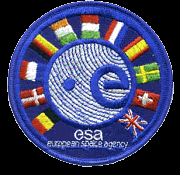ESA - European Space Agency patch.
17 August 2017
Astrophysicists are joining sightseers in watching Monday’s total solar eclipse across North America but, in the decade to come, they will be viewing eclipses that last for hours instead of a few minutes – thanks to a pioneering ESA space mission.
Aiming for launch in late 2020, Proba-3 is not one but two small metre-scale satellites, lining up to cast a precise shadow across space to block out the solar disc for six hours at a time, and give researchers a sustained view of the Sun’s immediate vicinity.
Proba-3
Total eclipses occur thanks to a remarkable cosmic coincidence: Earth’s Moon is about 400 times smaller than our parent star, which is about 400 times further away. During the rare periods when the two overlap, the Moon can sometimes blank out the Sun entirely.
This brief period of ‘totality’ – Monday’s will be just 160 seconds long at most – reveals features of the Sun normally hidden by its intense glare, most notably the faint atmosphere, known as its corona.
The corona is a focus of interest because it is the source of the solar wind and space weather that can affect satellites and Earth itself, especially through the irregular eruptions of energy called ‘coronal mass ejections’.
Solar eclipses
With temperatures reaching more than a million degrees celsius, the corona is also much hotter than the relatively cool 5500ºC surface of the Sun – a fact that seems to contradict common sense.
Researchers seek ways to increase the corona’s visibility, chiefly through ‘coronagraphs’ – telescopes bearing discs to block out the direct light of the Sun. These are used both on the ground and in space, as aboard the veteran Sun-watching SOHO satellite.
“The inner extent of the view afforded by standard coronagraphs is limited by stray light,” explains Andrei Zhukov of the Royal Observatory of Belgium, serving as Principal Investigator for Proba-3’s coronagraph.

Proba-3 satellites form artificial eclipse
“Stray light is a sort of light pollution inside an instrument. In coronagraphs it is a kind of bending of the sunlight around the blocking disc.
“This problem can be minimised by extending the coronagraph length, the distance between the camera and the disc, as far as possible – but there are practical limits to coronagraph size.
Proba-3's pair of satellites
“Instead, Proba-3’s coronagraph uses two craft: a camera satellite and a disc satellite. They fly together so precisely that they operate like a single coronagraph, 150 m long.”
Each six-hour artificial eclipse per 19.6 hour Proba-3 orbit of Earth should provide a view close to the Sun’s visible surface. This will span the current observing gap between standard coronagraphs and the extreme-ultraviolet imagers used to monitor the face of the Sun on missions such as NASA’s Solar Dynamics Observatory and ESA’s Proba-2.
The challenge is in keeping the satellites safely controlled and correctly positioned, using new technologies and sensors, plus intelligent software – autonomous driving, but this time in space.
Proba-3: Dancing with the stars
Proba-3 development is progressing well, with a structural and thermal model version of the coronagraph built, ahead of its critical design review this autumn, followed by that of the entire mission.
Related links:
Proba-3 mission: http://www.esa.int/Our_Activities/Space_Engineering_Technology/Proba_Missions
Science backing for formation-flying Sun-watcher Proba-3: http://www.esa.int/Our_Activities/Space_Engineering_Technology/Proba_Missions/Science_backing_for_formation-flying_Sun-watcher_Proba-3
Models of Proba-3 designs: http://www.esa.int/ESA_Multimedia/Images/2016/05/Models_of_Proba-3_designs
Proba-3: set the controls for the verge of the Sun: http://www.esa.int/Our_Activities/Space_Engineering_Technology/Proba_Missions/Proba-3_set_the_controls_for_the_verge_of_the_Sun
Eclipse 2017: http://cesar.esa.int/index.php?Section=Total_Eclipse_2017
Images, Video, Text, Credits: ESA/P. Carril/Wendy Carlos & Fred Espenak.
Greetings, Orbiter.ch




